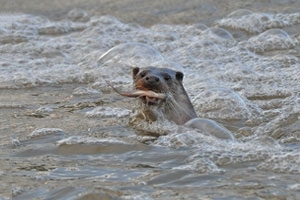Otter (Lutra lutra)
 When we hear so much about declining wildlife in the UK, it is great to be able to chat about a success story – that of the otter. Otters are part of the Mustelid family, so are related to badgers, pine martin, stoats and weasels and used to be widespread across the country.
When we hear so much about declining wildlife in the UK, it is great to be able to chat about a success story – that of the otter. Otters are part of the Mustelid family, so are related to badgers, pine martin, stoats and weasels and used to be widespread across the country.
However, back in the mid-1950s, organochlorine pesticides such as Aldrin and Dieldrin started to be used widely to control pests on farmland. These persistent chemicals were most commonly used as seed dressings and in sheep dips, but soon found their way into water courses and into the food chain and accumulated in top predators such as the otter.
This problem, coupled with the drainage of land and the general deterioration of water quality within our streams and rivers meant that, by the 1970s, otters were restricted mainly to Scotland, especially the islands and the northwest coast, western Wales and parts of the West Country, although in Ireland they remained widespread.
Slowly, however, since the withdrawal of these toxic pesticides and improvements to our watercourses, both in water quality and bank side habitat, otters have been spreading back into many areas. The first national otter survey, carried out between 1977 and 1979, detected the presence of otters in just over 5 per cent of the 2,940 sites surveyed; all the sites were known to have held the animals previously. But the fifth and most recent survey carried out between 2009 and 2010 showed that the figures have risen to nearly 60 per cent and that otters are now once again found in all English counties.
Surveys are based simply on the presence and absence of “spraints” which are the otter’s faeces which they often deposit in prominent places such as under bridges or on top of stones by the water’s edge to signal their whereabouts to other otters in the vicinity. Spraints can be identified by the characteristic sweet musky odour that they have and often further searching in the area will reveal distinctive footprints within the mud, confirming otters’ presence.
About three quarters of an otter’s diet is made up of fish, catching whatever is readily available, but eels are a particular favourite, although their numbers have crashed lately. The rest of the diet is made up of frogs, crayfish and occasional water-birds such as moorhen, and on coastal waters crabs. A male or “dog” otter weighs, on average, just over 8kg (the female or “bitch” is nearer to 6kg) and will eat up to 1.5kg of food a day. Otters have been known to live for up to 10 years, however a more normal lifespan would be nearer 5 years.
Male otters in particular can travel over large areas, with some using up to 40 kilometres or more of river habitat. Females have smaller ranges and breed once they are 2 or 3 years old choosing quiet, undisturbed areas, often smaller tributary streams with plenty of bank side vegetation to make their Holts (dens). Litters of two or three cubs (sometimes also called kits, pups or whelps) can be born at any time of the year and spend around 10 weeks in the holt, before venturing into the outside world. They will stay with the bitch for about a year before becoming totally independent. The dog otter has nothing to do with the bringing up of the young and lives completely separately from his family.
The major cause of death nowadays is from being run over by car or train, so conservationists are working closely with planners to the create passages under roads so that otters do not need to leave the watercourse to cross over highways. That aside, the future for otters in this country looks brighter now than it has for some time, which shows that we can get things right in the conservation world when we all work together.
Peter Thompson
Advisory

Download Peter Thompson's essential 26-page book, featuring beautiful photography and detailed profiles of Britain's wildlife
Download FREE >